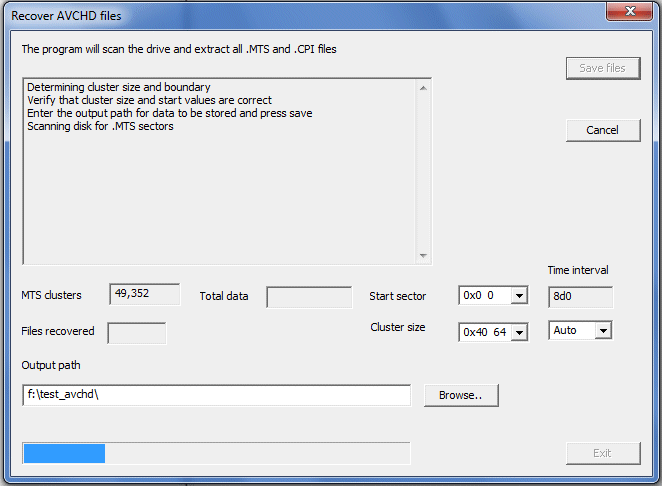|
AVCHD recovery
|   |
Video camera often use FAT to record data. When deleted, all details of any data fragments is lost. Also, on some cameras, all information about the location data is stored in is also lost. CnW have therefore created a special, dedicated function to scan the memory chip and recover all AVCHD video clips. Unlike many other recovery programs, it will produce a number of long clips rather than 100s of short clips that have to joined together by hand. The process allows for fragmented and deleted files.
The routine was designed for memory chips but with V3.91 the 128GB limit has been overcome. Recovery from hard drives is not recommended, but only due to speed issues. The routine does examine every sector and for a 1TB drive this will take a few hours. However, good results will be achieved.

The program is a two stage process
Where CnW Recovery scores over other recovery programs is that it examines the whole memory chip first. It logs the start and end of each cluster of video. From this table it can build complete files, rather than just short fragments. On one rweal life example 8GB memory chip, there were about 500 fragments, which competeing software produced as 500 MPL files. CnW reconstructed the correct number of about 60 files. Where possible (ie the information exists) the original dates of the video files are extracted.
Setup parameters
There are two important paramters that must be set correctly before starting. The first is the sector start and cluster size. For FAT chips these are often (but always) determined by the program. The start sector is an offset of the cluster on the disk, and is modulus the cluster size. If the values are wrong then there will be many more files produced. For most memory chips, the values appear to be start sector 0, and cluster size of 0x40 64.
For non FAT disks the cluster size and start sector may be different. eg NTFS may have a typical cluster size of 0x8 and often a start sector of 0x0 or sometimes on XP drives 0x7
The time interval is the interval between frames of video. Auto may be selected, or fixed values of 0x8D0 or 0x69C, 0x5ab, 0xb96 may be selected. If the value is wrong, the symptom is many short files being found rather than 10s or 100s or reasonable sized files. If none of the options work, please send some sample (short) .MTS files to CnW and a new value will be added.
How to view AVCHD files
AVCHD is a complex format that is a mix of MPL and CPI files. All tne video is stored in MPL files, and these can be viewed through programs such as MediaPlayer - but only on Windows 7 (ie not XP). CnW recovers files, but does not create valid file names, ie the MPL and CPI do not necessarilly tie up. One suggested method of recovery is to copy the recovered, complete files back onto a memory chip, and get the video camera to re-index the files. This should produce a memory chip in the format as it was before the files were deleted, or corrupted.
To view a files on an XP PC you will need to download a compatible viewer - do a Google search for possible viewers.
NB Never write to the original problem disk/memory chip unless you have a copy of the disk. If it is required to write to a memory chip to re-index in a camera, either use new chip, or make sure you have a complete, secure image of the original chip (using Image Disk function).